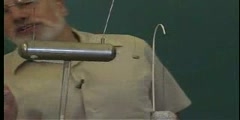Lec 12 - Physics 111: Introduction to Error Analysis
Physics 111: Introduction to Error Analysis Physics 111 Advanced Laboratory. Professor Sumner Davis This video accompanies the Error Analysis exercise, providing students with an introduction to the theory and procedures. In many labs, you will be required to perform a detailed analysis of the data you have acquired to make quantitative statements about the properties of the physical world. A common question is, are your measurements consistent with a particular theory or not? This question can be answered only by careful analysis of systematic uncertainties and statistical error. The goals of this exercise are twofold. One is to introduce you to the basics of error analysis. The second is to familiarize you with the Matlab software that you will be using for data analysis . Ideally, this will serve as a guide during the acquisition and analysis of data throughout the advanced lab. http://advancedlab.org
Video is embedded from external source so embedding is not available.
Video is embedded from external source so download is not available.
Channels: Physics (General)
Tags: Physics 111: Introduction to Error Analysis
Uploaded by: berkeleyphy111 ( Send Message ) on 19-09-2012.
Duration: 51m 22s
Here is the next lecture for this course
Introduction to Physics Spring 2010
01:11:11 | 2724 viewsPhysics Lab Demo 1: Introduction to Elect ...
03:31 | 11764 viewsLec 28 - Physics 111: Non-Linear Dynamics ...
45:56 | 5554 viewsLec 25 - MIT 3.091 Introduction to Solid ...
45:42 | 3002 viewsLec 1 - Course Introduction and Newtonian ...
01:13:21 | 3803 viewsLec 14 - Introduction to the Four-Vector
01:12:35 | 3634 viewsLec 2 - 8.01 Physics I: Classical Mechani ...
38:11 | 3360 viewsLec 35 - An Introduction to Computational ...
01:53:53 | 4654 viewsLec 1 - Introduction - Introduction to Th ...
39:29 | 3452 viewsLec 1 - Modern Physics: Statistical Mechanics
02:00:52 | 3144 viewsLec 13 - Introduction to Chemical Engineering
39:37 | 2703 viewsLec 19 - CS 61B Asymptotic Analysis
48:51 | 3398 viewsLec 20 - CS 61B Algorithm Analysis
44:16 | 2980 viewsLec 35 - CS 61B Amortized Analysis
46:27 | 3282 viewsLec 36 - CS 61B Randomized Analysis
57:37 | 2423 viewsNo content is added to this lecture.
This video is a part of a lecture series from of berkeley
Lecture list for this course
Lec 1 - Physics 111: Atomic Physics (ATM) Part 1. Balmer Series
Lec 2 - Physics 111: Atomic Physics (ATM) Part 2. Zeeman Effect
Lec 3 - Physics 111: Beta Ray Spectroscopy (BRA)
Lec 4 - Physics 111: Brownian Motion in Cells (BMC)
Lec 5 - Physics 111: Instrumentation Section Lab Equipment (BSC)
Lec 6 - Physics 111: Bubble Chamber (BBC)
Lec 7 - Physics 111: Carbon Dioxide Laser (CO2)
Lec 8 - Physics 111: Compton Scattering (COM)
Lec 9 - Physics 111: Gamma Ray Spectroscopy (GMA)
Lec 10 - Physics 111: Hall Effect In A Plasma (HAL)
Lec 11 - Physics 111: Holography (HOL)
Lec 13 - Physics 111: Josephson Junction Effect (JOS)
Lec 14 - Physics 111: Radiation and Laboratory Safety
Lec 15 - Physics 111: Laser Safety
Lec 16 - Physics 111: Atomic Physics (ATM) Theory Lecture ONLY
Lec 17 - Physics 111: Energy Levels Lecture Part 1
Lec 18 - Physics 111: Energy Levels Lecture Part 2
Lec 19 - Physics 111 Light Sources and Detectors Lecture
Lec 20 - Physics 111: Optical Instruments Lecture
Lec 21 - Physics 111: Energy Transitions Lecture Series
Lec 22 - Physics 111: Laser Induced Fluorescence and Raman Scattering (LIF)
Lec 23 - Physics 111: Low Light Signal Measurements (LLS)
Lec 24 - Physics 111: Non-Linear Spectroscopy and Magneto-Optics Part 1 (MNO)
Lec 25 - Physics 111: Non-Linear Spectroscopy and Magneto-Optics Part 2 (MNO)
Lec 26 - Physics 111: Atom Trapping (MOT)
Lec 27 - Physics 111: Muon Lifetime (MUO)
Lec 28 - Physics 111: Non-Linear Dynamics and Chaos (NLD)
Lec 29 - Physics 111: Nuclear Magnetic Resonance (NMR) Part-1 Continuous Wave
Lec 30 - Physics 111: Nuclear Magnetic Resonance Part-2 Pulsed NMR
Lec 31 - Physics 111: Optical Pumping (OPT)
Lec 32 - Physics 111: How to do an Oral Report
Lec 33 - Physics 111: Optical Trapping (OTZ)
Lec 34 - Physics 111: Rutherford Scattering (RUT)
Lec 35 - Physics 111: Hall Effect In A Semiconductor
















